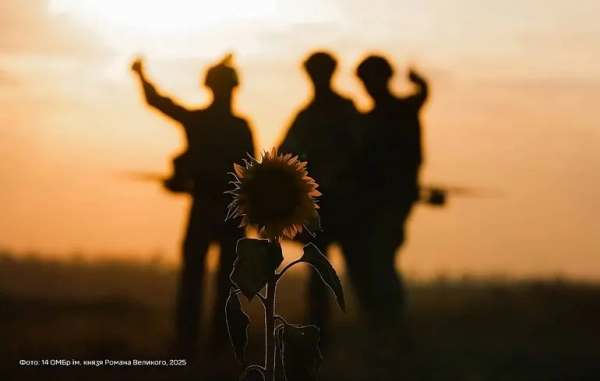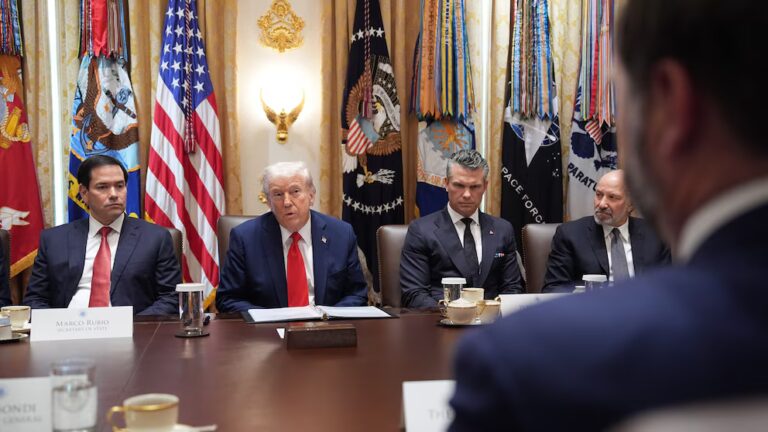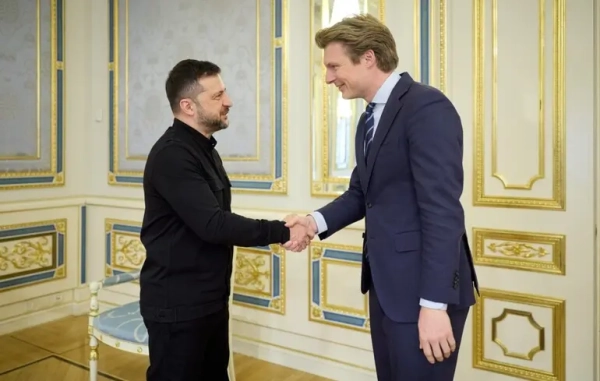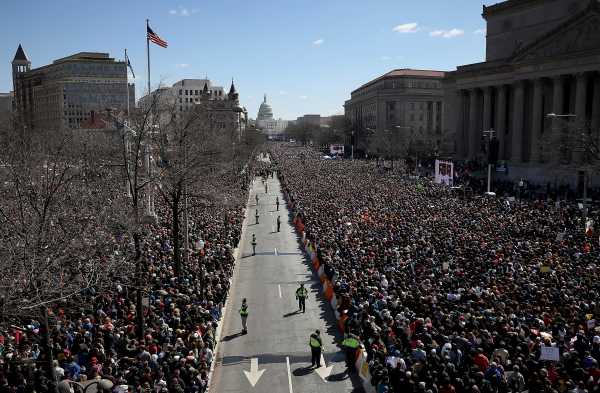
At least 1.2 million people marched for gun control over the weekend at events across the US, according to early tallies from researchers Erica Chenoweth and Jeremy Pressman.
The count is still preliminary: The researchers estimate that there were more than 450 marches in the US over the weekend but only have crowd estimates for about half of them.
There’s also a lot of uncertainty with individual marches. The biggest march — in Washington, DC — drew anywhere from 200,000 to 800,000 people, depending on whether you believe the low-end number put out by the private firm Digital Design & Imaging Service or the high-end number from march organizers.
The higher estimate would make the March for Our Lives “the largest single-day protest in the history of the nation’s capital,” according to USA Today. But Digital Design & Imaging Service estimates that the March for Our Lives was in fact smaller than the first Women’s March in 2017, which by its count drew 440,000 to DC.
Regardless, March for Our Lives was one of the biggest rallies for gun control ever in the nation’s capital (at least since the Million Mom March in 2000) — and one of the biggest youth protests since the Vietnam War, according to the Associated Press.
Other March for Our Lives protests around the country drew anywhere from dozens to nearly 200,000 people over the weekend, based on Chenoweth and Pressman’s tally so far. The researchers are asking for people to submit more data to them to get a better count.
The March for Our Lives is a direct response to the Marjory Stoneman Douglas High School shooting in Parkland, Florida, which killed 17. The massacre inspired student survivors to launch a movement in hopes of convincing lawmakers to address the issue of gun violence and, in particular, school shootings.
The protesters plan to continue growing their movement, persuading people to register to vote and attend town halls. In invigorating people to act solely on the issue of gun control, the movement really could make a difference — and potentially push Congress to finally pass significant gun reforms after years of little to no action.
Gun control is, broadly speaking, incredibly popular in America. Polling for many common gun control measures, including universal background checks, can top 75 percent — even among Republicans.
But for years, these policies have failed to get anywhere in Congress because of a key problem: issue intensity. Essentially, lots of Americans support gun control, but it’s not really their top priority when they go out to vote. Meanwhile, those who oppose stricter gun laws are simply more likely to make it the one issue they’ll vote on.
This was articulated by Republican strategist Grover Norquist back in 2000. He said, “The question is intensity versus preference. You can always get a certain percentage to say they are in favor of some gun controls. But are they going to vote on their ‘control’ position?” Probably not, he suggested, “but for that 4-5 percent who care about guns, they will vote on this.”
That’s what makes movements like the March for Our Lives, and much of the activism that’s followed the Parkland shooting, so important. For once, we are seeing a mass movement that is extremely dedicated to gun control. And by attracting so much national attention, the movement may inspire other Americans to follow suit, making gun control an issue that can actually sway votes.
That’s not to say the March for Our Lives and related movements will ultimately succeed — it’s just too soon to tell. But as hundreds of thousands of protesters took to the streets in DC and the rest of the country on Saturday, it became clear that the movement’s apparent potential to promote and boost issue intensity on gun control could ultimately make it pivotal.
Some gun control measures are extremely popular, even among Republicans
Congress’s inaction on guns over the past few years is not due to the unpopularity of gun control measures. If you look at the polling, support for gun control, depending on which specific measure respondents are asked about, can be very high among both Democrats and Republicans.
Here, for example, are the results of surveys by the Pew Research Center, which found strong support for measures ranging from an assault weapons ban to universal background checks to restrictions on people with mental illness buying guns:
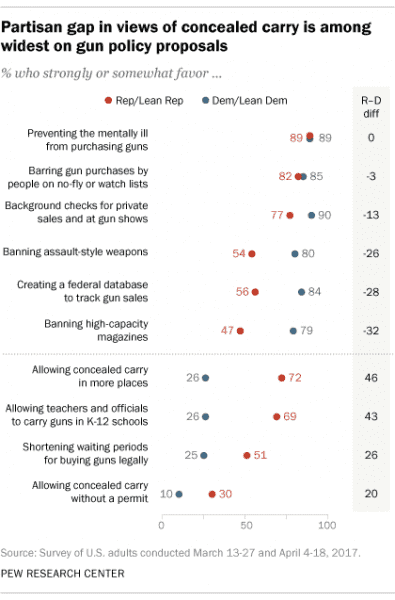

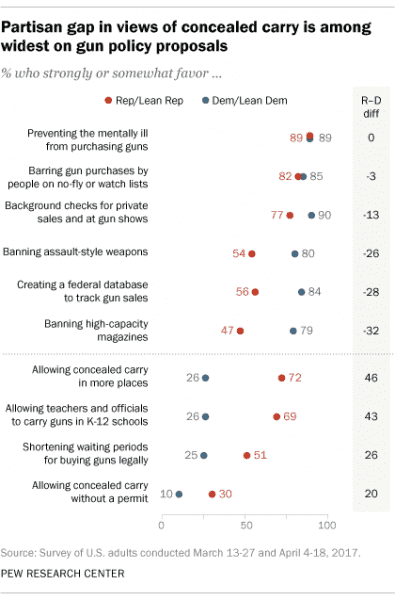
What’s remarkable about the polling is how much of it reflects bipartisan support for new gun control measures. A majority of Republicans back universal background checks, a ban on assault-style weapons, a federal database to track gun sales, prohibitions on people with mental illness, and barring people on no-fly or watch lists from buying firearms. In fact, GOP support for three of these policies tops 75 percent.
That’s not to say Republicans agree with all gun control measures. And a majority back measures that gun control proponents oppose, including allowing concealed carry in more places, shortening waiting periods for buying guns legally, and arming teachers.
But there’s a lot of remarkable middle ground — which you wouldn’t know about if you just looked at Congress’s record passing new restrictions on firearms.
Issue intensity is the key
This is where issue intensity comes in. Consider this chart, also from Pew:
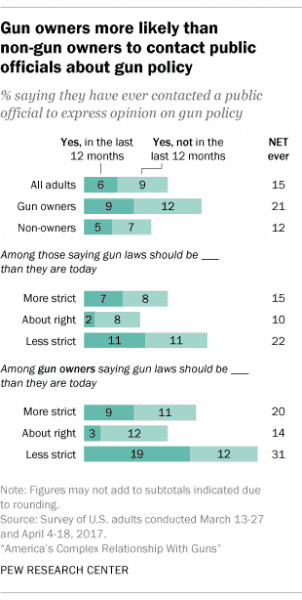

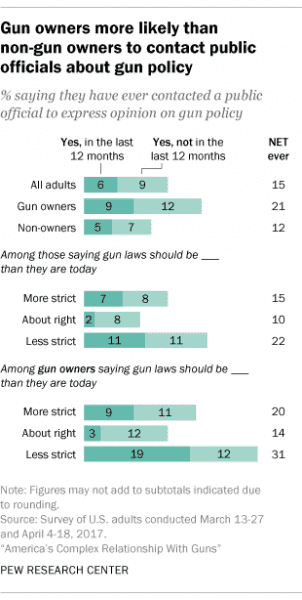
About 21 percent of gun owners have contacted a public official to express an opinion on gun policy, compared to just 12 percent of non-gun owners. And about 22 percent of people who want less strict gun laws have contacted a public official, while just 15 percent of people who support stricter laws have.
The differences are more pronounced if you look at contact in the previous 12 months. Gun owners are 80 percent more likely than non-gun owners to have contacted a public official about gun policy in the past year. And supporters of laxer gun laws are nearly 60 percent more likely than supporters of stricter gun laws to have contacted a public official over the issue in the same time span.
This difference in issue intensity also shows up in other areas. Take this second chart:
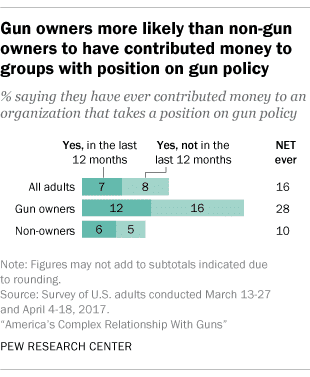

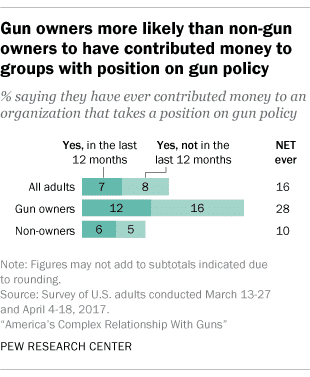
Again, the situation is skewed in favor of gun owners. About 28 percent of gun owners have contributed to an organization that takes a position on gun policy, while only 10 percent of non-gun owners have. That helps explain how a group like the National Rifle Association (NRA) has become so powerful, while there are no political equivalents — in terms of influence — on the other side.
One caveat to the charts: Based on Pew’s surveys, there are way more adults in the US who believe gun laws should be stricter (52 percent) than those who believe gun laws should be less strict (18 percent). So the side in favor of stricter gun laws can afford to have a lower percentage of its people contacting public officials.
It’s demonstrative, though, to focus on the 12-month data for this. As it shows, gun owners and supporters of laxer gun laws are more likely to have recently engaged a public official or political organization on this issue. That matters: If a senator gets phone calls every few months from gun owners and opponents of stricter laws, that’s going to make a bigger impression than calls from non-gun owners and supporters of stricter laws every year or so.
That’s especially true if you consider political party. Republicans are much more likely to oppose stricter laws, based on Pew’s data. So if a Republican senator mostly hears from GOP constituents, and these constituents are more likely to be really passionate about the issue since they are on the side that opposes stricter laws, that’s going to give the senator a skewed perception of where voters are on this topic. As a result, Republican lawmakers are more resistant to calls for gun control — arguing against “politicizing” mass shootings and focusing on issues like mental health instead.
So why the difference in passion? Kristin Goss, a political scientist at Duke University and author of The Gun Debate: What Everyone Needs to Know, previously told me that it’s a sense of tangible loss. Gun owners feel like the government is going to take their guns and rights.
This sentiment has been fueled by a decades-long public campaign by the NRA to convince the US public and politicians that, in fact, the Second Amendment guarantees an individual right to bear arms, and that more guns will actually make people safer (by letting them protect themselves), despite research that shows higher levels of gun ownership actually lead to more gun violence.
Gun control advocates, meanwhile, are motivated by more abstract notions of reducing gun violence — although, Goss noted, the victims of mass shootings and their families have begun putting a face on these policies.
That’s exactly what the current protests are doing, with student survivors from Florida in particular actively participating and showing the human, personal cost of unabated gun violence in a very public manner. Success isn’t guaranteed. But the potential to inspire more widespread and passionate empathy and sympathy through these demonstrations could crack the key problem facing the gun control movement today.
Sourse: vox.com
